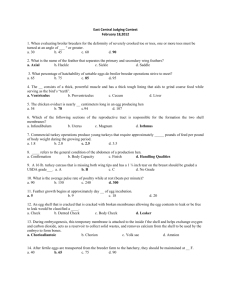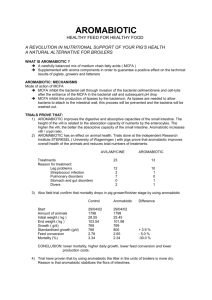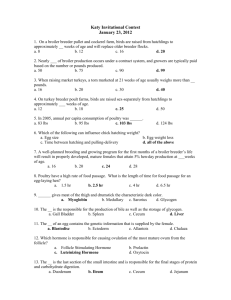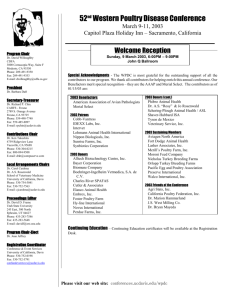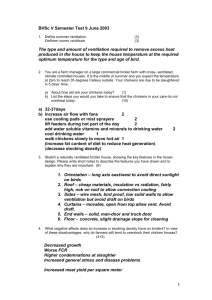International Journal of Animal and Veterinary Advances 3(1): 44-46, 2011
advertisement
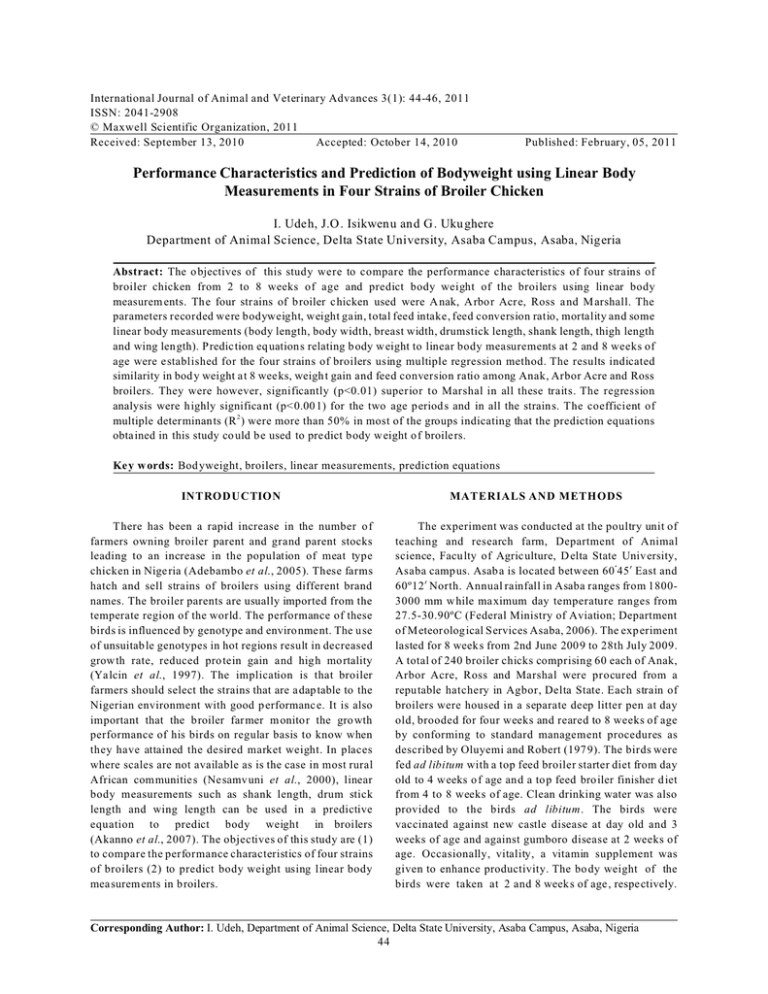
International Journal of Animal and Veterinary Advances 3(1): 44-46, 2011 ISSN: 2041-2908 © Maxwell Scientific Organization, 2011 Received: September 13, 2010 Accepted: October 14, 2010 Published: February, 05, 2011 Performance Characteristics and Prediction of Bodyweight using Linear Body Measurements in Four Strains of Broiler Chicken I. Udeh, J.O . Isikwenu and G. Uku ghere Department of Animal Science, Delta State University, Asaba Campus, Asaba , Nigeria Abstract: The o bjectives of this study were to compare the performance characteristics of four strains of broiler chicken from 2 to 8 weeks of age and predict body weight of the broilers using linear body measurem ents. The four strains of b roiler chicken used were A nak, A rbor Acre, Ross a nd M arshall. The parameters recorded were bodyweight, weight gain, total feed intake, feed conversion ratio, mortality and some linear body measurements (body length, body width, breast width, drumstick length, shank length, thigh length and wing length). Prediction eq uations relating b ody w eight to linear body measurements at 2 and 8 weeks of age were established for the four strains of broilers using multiple regression method. The results indicated similarity in bod y weight at 8 weeks, weigh t gain and feed conversion ratio among Anak, Arbor Acre and Ross broilers. They were however, significantly (p<0.01) superior to Marshal in all these traits. The regression analysis were highly significant (p< 0.00 1) for the two age period s and in all the strains. The coefficient of multiple determinan ts (R 2 ) were more than 50% in most of the groups indicating that the prediction equations obtained in this study co uld be used to predict body w eight of broilers. Key w ords: Bod yweight, broilers, linear measurements, prediction equations INTRODUCTION MATERIALS AND METHODS T here has been a rapid increase in the number of farmers owning broiler parent and grand parent stocks leading to an increase in the population of meat type chicken in Nige ria (Adebambo et al., 2005). These farms hatch and sell strains of broilers using different brand names. The broiler parents are usually imported from the temperate region of the world. The performance of these birds is influenced by genotype and enviro nment. The use of unsuitab le genotypes in hot regions result in decreased growth rate, reduced pro tein gain and high mortality (Ya lcin et al., 1997). The implication is that broiler farmers should select the strains that are adap table to the Nigerian environment with good p erformanc e. It is also important that the broiler farmer m onitor the gro wth performance of his birds on regular basis to know when they have attained the desired market weight. In places where scales are not available as is the case in most rural African com munities (Ne samvuni et al., 2000), linear body measurements such as shank length, drum stick length and wing length can be used in a predictive equation to predict body weight in broilers (Akanno et al., 2007). The objectives of this study are (1) to compare the performance characteristics of four strains of broilers (2) to predict body weight using linear body measurem ents in broilers. The experiment was conducted at the poultry unit of teaching and research farm, Department of Animal science, Faculty of Agriculture, D elta State University, Asaba campus. Asab a is located between 60 º45! East and 60º12! North. Annual rainfall in Asaba ranges from 18003000 mm w hile maximum day temperature ranges from 27.5-30.90ºC (Federal Ministry of Aviation; Department of Meteorological Services Asaba, 2006). The exp eriment lasted for 8 weeks from 2nd June 200 9 to 28th July 2009. A total of 240 broiler chicks comprising 60 each of Anak, Arbor Acre, Ross and Marshal were procured from a reputable hatchery in Agbor, Delta State. Each strain of broilers were housed in a separate deep litter pen at day old, brooded for four weeks and reared to 8 weeks of age by conforming to standard management procedures as described by Oluyemi and Robert (197 9). The birds were fed ad libitum with a top feed broiler starter diet from day old to 4 weeks o f age and a top feed broiler finisher d iet from 4 to 8 weeks of age. Clean drinking water was also provided to the birds ad libitum. The birds were vaccinated against new castle disease at day old and 3 weeks of age and against gumboro disease at 2 weeks of age. Occasionally, vitality, a vitamin supplement was given to enhance productivity. The bo dy weight of the birds were taken at 2 and 8 weeks of age, respectively. Corresponding Author: I. Udeh, Department of Animal Science, Delta State University, Asaba Campus, Asaba, Nigeria 44 Int. J. Anim. Veter. Adv., 3(1): 44-46, 2011 Table 1: Mean performance values for four strains of broiler chicken Param eters Anak Arbor A cre Ross Marshal Initial weight at 2 weeks (g) 403.30 b 385.08 b 340.53 a 342.85 a Final weight at 8 weeks (g) 1855.00 b 1880.00 b 1812.50 b 1645.00 a Total weight gain(g) 1451.70 b 1494.92 b 1471.97 b 1302.15 a Total feed intake (g/bird) 2599.90 a 2799.99 b 2799.95 b 2799.91 b Fee d co nve rsion ratio 1.79 a 1.87 a 1.90 a 2.15 b M ortality (%)* 1.50 2.30 1.60 0.00 *: N ot teste d sta tistically; a, b : m ean with in a ro w w ith dif feren t sup ersc ripts a re sig nifica ntly (p< 0.0 1) d iffere nt Table 2: Re gression equation relating body weight and linear body m easureme nts at 2 and 8 w eeks of age for four strains of broiler chicken Strain type Prediction equation R2 Anak B W T2 = 8 58 .1 3 – 1 2 .5 2 BL T – 3 8 .8 7 BR W + 5 3 .4 4 BD W – 7 .3 1 D SL – 1 2 4. 35 S HL – 4 2 .1 8 TH L + 5 2 .5 6 W G L 50.86 B W T8 = 6 35 7 .1 6 – 1 4 4. 22 B LT – 23 1 .6 7 BR W + 1 4 2. 55 B D W – 10 5 .5 1 D SL – 5 4 .2 1 SH L + 1 2 1. 14 T HL + 41 .9 5 W G L 38.62 Arbo r Acre B W T2 = -9 5 9. 50 – 3. 70 B LT – 0. 88 B R W + 11 4 .4 2 BD W + 4 4 .4 3 D SL – 1 3 .7 4 SH L + 3 0 .8 7 TH L + 1 8 .6 1 W G L 67.72 B W T8= -2 9 3. 96 + 10 .6 4 BL T + 2 3 5. 02 B R W + 30 .1 9 BD W + 1 9 .5 2 D SL + 18 .3 9 SH L – 9 3 .7 3 TH L + 7 .8 0 W G L 8.06 M ars hal B W T2 = -2 2 6. 52 + 0. 14 B LT + 6. 65 B R W – 4. 80 B D W – 46 .7 1 D SL + 17 .5 9 SH L + 4 2 .0 7 TH L + 2 5 .6 9 W G L 61.22 B W T8 = -4 0 47 .2 5 + 3 4 .9 8 BL T – 1 1 4. 83 B R W – 8. 12 B D W + 27 0 .2 7 D SL + 11 2 .7 5 SH L + 1 4 4. 90 T HL + 37 .9 9 W G L 31.00 Ross B W T2 = 6 6. 44 – 4. 24 B LT – 15 .8 9 BR W + 2 .5 4 BD W + 3 0 .5 8 D SL – 2 5 .5 8 SH L – 7 .2 1 TH L + 3 8 .2 2 W G L 54.47 B W T8 = 1 38 1 9. 22 – 17 9 .0 9 BL T + 2 3 0. 07 B R W – 33 4 .9 4 BD W – 4 1. 96 D S L + 4 9. 98 S HL – 1 9 8. 36 T HL + 52 .6 3 W G L 55.32 B W T2 BTW 8 = Body weight at 2 and 8 weeks of age, respectively; BLT = Body length; BRW = breast width; BDW = Body width; DS L = drums tick length; TH L – thigh length; W GL = w ing length. R 2 = Coefficient of multiple determinant, SE = standard error. ***: p<0.001 Feed intake was taken on daily basis. Feed conversion ratio was calculated as feed intake divided by weight gain. The linear body measurements (body length, body width, breast width, drum stick length, shank length, thigh length and wing length) were measured on weekly basis using a tape. The data collected on each parameter were subjected to one w ay analysis of variance in a com pletely randomized design. T he following statistical model was used in the ana lysis: S.E .M 13.52 45.82 37.74 43.31 0.07 S.E 46.92 186.42 36.76 197.09 24.51 143.77 24.35 96.36 length; SHL Sig. *** *** *** *** *** *** *** *** – shank 1610.00, 1758.21 and 1468.21 g at 8 weeks of age for Anak, Arbor Acre and Ross broilers respectively. Body weight gain at 8 weeks of age were similar among Anak, Arbor Acre and Ro ss but significantly (p<0.01) higher than the value for Marshal. This implies that Anak, Arbor Acre and Ross broilers had greater genetic potential for growth compared with M arshal. Total feed intake (g/bird) were similar in Arbor Acre, Ross and Marshal but higher than the value for Anak. Marshal broilers were the poorest feed converters as they consumed more feed and gained less weight when compare to the other groups. Feed conversion ratios were similar in Anak, Arbor Acre and Ross broilers. Arbor Acre recorded the highe st mortality, followed by Ro ss and Anak. M arshal did no t record any mortality throughout the perio d. Regression equations relating body weight to body parameters with their accuracy of prediction (R2 ) values for the four strains of broilers are shown in Table 2. It will be observed that the regression analysis were highly significant (p<0.001) in all the groups and the R 2 values more than 50% in most of the group s. This suggests that the body parameters are very good predictors for body weight in broilers. Therefore, in the rural areas where scale is not available, any of these body parameters could be used to predict the body weight of broiler chicken . A similar observation was reported by Akanno et al. (2007). Yij = U + Xi + eij where , Yij = The observation (body weight, feed intake, feed conversion ratio) made on the jth individual belonging to the ith strain of broilers. U = over all estimate of the population mean. xi = Effect of the ith strain of broiler (i = 1,2 ,3,4,) eji = Random error associated with each measurem ent. Multiple regression models were fitted to determine predictio n equa tions for the four strains of broilers at 2 and 8 wee ks of age resp ectively. RESULTS AND DISCUSSION Table 1 presents the mean performance values for the four strains of broiler chicken. H ighly significant (p<0.01) differences were observed among the four strains of broilers in the initial bo dyweight at 2 weeks and the final body weight at 8 weeks of age. The Anak and Arbor Acre broilers were heavier at 2 weeks of age comp ared to R oss and Marshal. At 8 we eks of age, the A nak, A rbor Acre and Ross broilers attained an average body weight of 1855.00, 1880.00 and 1812.50 g, respectively which were higher than that of M arshal (1645.00 g). Akanno et al. (2007) recorded an average bodyweight of CONCLUSION It was concluded that Anak, Arbor A cre and R oss broilers showed sim ilarity in body weight at 8 weeks of age, weight gain and feed conversion ratio. They were, however, significantly (p<0.01) superior to Marshal broilers in all these traits. T he results of multiple regression analysis showed that it was possible to predict bod yweight of bro ilers using line r body me asurements. 45 Int. J. Anim. Veter. Adv., 3(1): 44-46, 2011 Akanno, E.C., P.K . Ole, I.C . Okoli and U.E. O gundu, 2007. Performance characteristics and prediction of body weight of broiler strains using linear body measurem ents. Proceeding 22nd Annual Conference Nig. Soc. for Animal Prod. Calabar, pp: 162-164. Nesamvuni, A.E., J. Malandzii, N.D. Zamanyimi and G.J. Taylor, 2000. Estimates of body weight in Nguru type cattle under commercial management conditions. South Afr. J. Anim. Scie., Vol. 30. Oluye mi, J.A. and F.A. Roberts, 1979. Po ultry Production in Warm W et Climates. 2nd Edn., Macm illan Press Ltd., London. Yalcin, S., P. Settar, S. Ozkan and A. Cahaner, 1997. Comparative evaluation of three commercial broiler stocks in hot versus temperate climates. P oultry Sc., 76: 9 21-9 29. ACKN OW LEDGM ENT The authors were grateful to the Department of Animal science, Delta State University, Asaba Cam pus for allowing us use their facilities for this research. REFERENCES Adebambo, A.O., O.I. Faybenvo, S.O. Fragite, C.O.N. Ikeobi and O.A. Adebambo, 2005. Preliminary assessm ent of growth and reproductive data of three strains of chickens for broiler development in Nigeria. Proceeding 1st Nigeria international pou ltry summit. Ota Ogun State, pp: 9-11. 46
